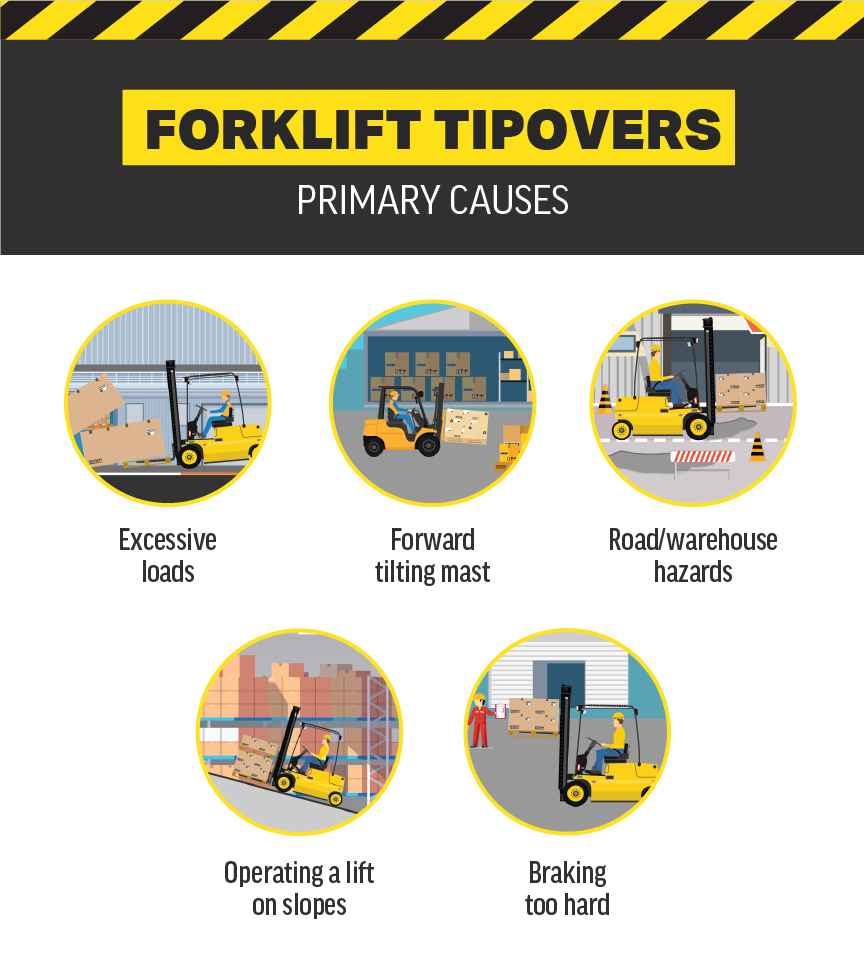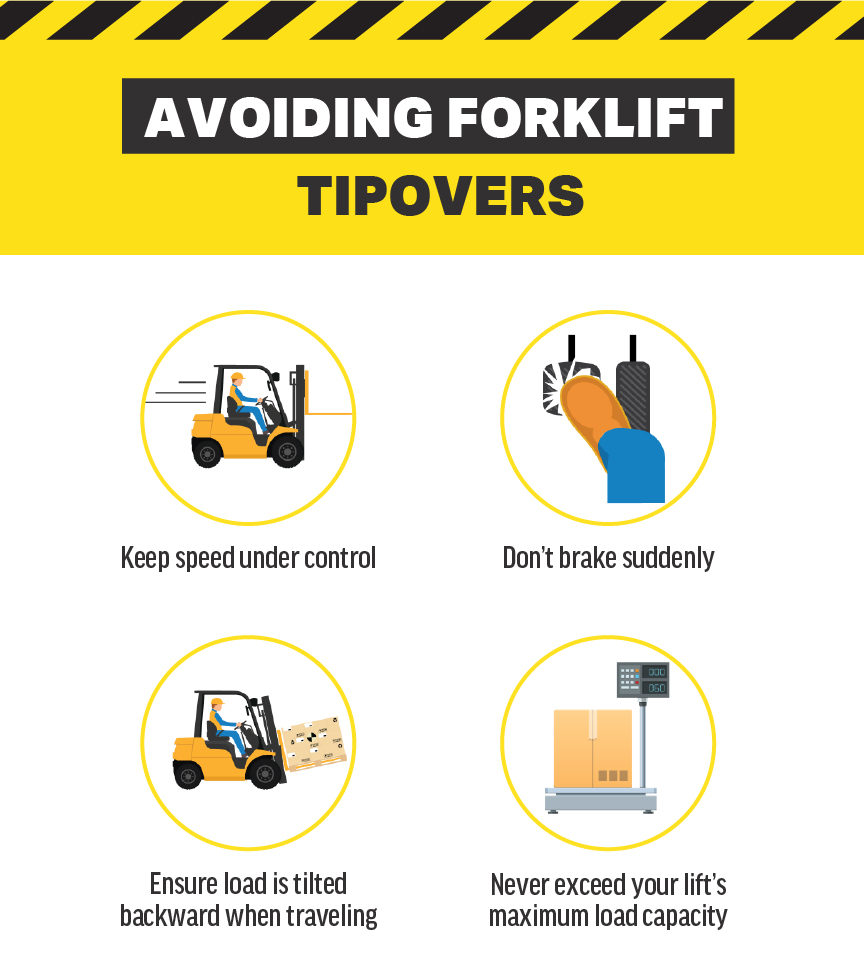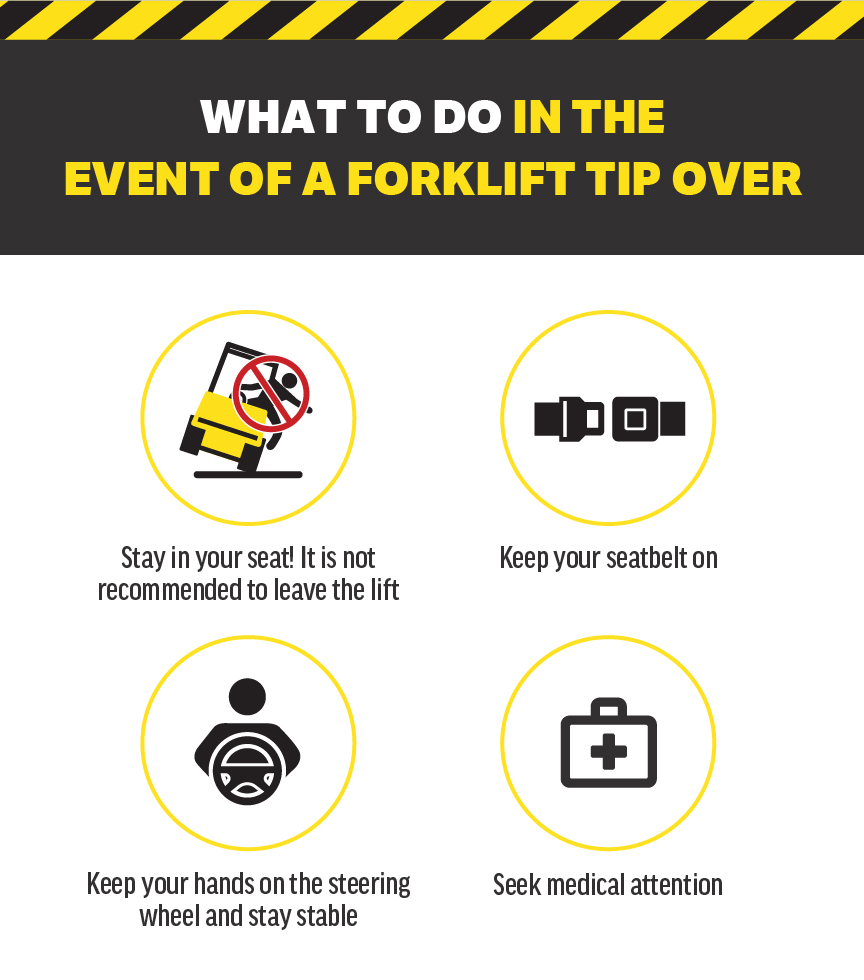Can Forklifts Tip Over?
What Causes Forklift Tip Overs?
When a forklifts centre of gravity is directly above its wheelbase they are generally a very stable piece of equipment.
The most common forklift tip overs occur when the unit tips either forward or to one side.
- Sideways Tip Overs occur when a forklifts centre of gravity shifts too far to the left or right of the wheelbase, which can occur during sharp or sudden turns.
- Forward Tip Overs occur when a forklifts centre of gravity shifts too far forward, which can happen when it is being driven down a ramp.
Common Causes of Sideways Forklift Tip Overs
1. Abrupt sudden turns
Sudden and abrupt turns of a fully loaded forklift can cause the units centre of gravity to shift to either the right or left.
The shift of the centre of gravity to one side may cause the wheels on one side of the forklift to raise off the ground.
When the wheels leave the ground it is near on impossible for the operator to recover and ground the forklift again, therefore resulting in the unit tipping over sideways.
2. Trying to turn with an excessively high raised load
The higher a load is stacked or raised on a forklifts mast the less stable it is, the load may shift on the tynes which can dramatically affect the weight distribution of the load.
Trying to turn a corner with the load raised to high will affect the unit’s centre of gravity heightening the risk of a tip over occurring.
3. Trying to turn whilst on a slope
Driving a fully loaded forklift up or down an incline or slope can increase the risk of a tip over.
Upsetting the unit’s centre of gravity whilst it is on an incline can be extremely dangerous as not only will the forklift tip over it, depending on the height of the slope it can also fall down or off the incline resulting in serious operator injury or fatality as well as damage to the load and the forklift.
4. Driving over obstacles
It is recommended to operate standard counterbalance forklifts on smooth concrete surfaces, poorly maintained operating surfaces with potholes or other obstacles are a danger to fully loaded forklifts.
Operators driving the forklift at speed and unexpectedly hitting a pothole can disrupt its centre of gravity increasing the chances of a tip over.
Common Causes of Forward Forklift Tip Overs
1. Carrying loads that exceed the forklifts rated capacity
When a forklifts centre of gravity shifts to far forward due to an operator trying to lift and transport a load that exceeds the manufacturer’s safe rated capacity it can cause the unit to become imbalance and unstable.
The operator must always ensure the load is balanced out by the forklifts counterbalance or risk a forward tip over.
2. Carrying loads with the mast tilted forwards
A mast tilted forward to far forward can cause the forklift to become unstable and result in a forward tip over.
The chances of this happening are heightened when the forklift is being driven down an incline and is why operators should always drive the forklift backwards down a ramp or slope.
3. Sudden movements – accelerating or braking suddenly
Abrupt movements such as accelerating or braking suddenly can shift a forklifts centre of gravity and becoming unstable raising the likelihood of a tip over.
4. Raising or lowering loads on a slope
Raising or lowering a load whilst the forklift is positioned on a slope may shift its centre of gravity causing a tip over.

4 Safety Tips to Help Avoid Forklift Tip Overs
Below four common safety tips for avoiding forklifts tip overs are discussed.
1. Slow down and do not exceed speed limits
Operating a forklift at high speed is extremely dangerous as it becomes harder to control.
Due to the considerable size and weight of the forklift with the addition of a full load a speeding out of control forklift has an increased chance of tipping over and causing serious injury or damage.
Operators should always operate a forklift at steady speed and never exceed any posted speed limits within a facility.
2. Always ensure a forklifts mast, tynes and load are tilted backwards when travelling
Ensuring a forklifts mast, tynes and load are always tilted backwards during transport helps to stabilise the unit’s centre of gravity.
A stable centre of gravity greatly reduces the likelihood of the forklift tipping over.
3. Avoid accelerating or braking suddenly
Smooth acceleration and braking eliminates the likelihood of the forklift making sudden jerking movements that may disrupt its centre of gravity eliminating a common cause of tip overs.
4. Know your forklifts maximum rated capacity and never exceed it
It is imperative that all operators know and understand their forklifts maximum safe rated capacity as defined by the manufacturer.
Ensuring all loads are within a forklifts safe lift capacity means the unit will never be overloaded reducing the chances of a forward tip over.

4 Things to Do in the Event of a Forklift Tip Over
In the event of a forklift tip over we recommend operators do the following four things.
1. Stay seated, it is not recommended to leave the forklift unless in an emergency
In the event of a forklift tip over it is highly recommended for the operator to stay seated and to not try and leave the forklift until they have been medically examined and deemed safe to move.
Depending on the severity of the tip over operators can sustain serious internal injuries that can unexpectedly exacerbated if they’re moved without proper examination.
Operators should always try and remain in the forklift unless there is a life threatening emergency such as a fire ignited by leaking combustible fluids from the unit such as diesel or LPG fuel.
2. Keep your seatbelt on
Operators should always keep their seatbelt on in the event of a tip over.
Depending on which way the forklift has tipped over the operator may be suspended upside down, the seat belt keeps them safe and secure until the forklift can turned up the right way.
Seat belts also ensure the operator will not suffer any subsequent fall or injury if the tip over was to occur on a slope falling over an edge.
3. Keep your hands on the steering wheel and stay stable
Operators should never take their hands of the steering wheel in the event of a forklift tipping over.
This is particularly important if the tip over were to occur on a slope, if the steering wheel is being turned as the tip over is occurring the forklift may actually be steered over the edge of slope.
4. Seek immediate medical attention

Employees attending the scene of a forklift tip over should seek immediate medical attention for the operator and anyone else injured as a result.
Depending on the severity of any sustained injuries operators and employees may need essential medical care or transport to hospital for treatment to minimise the likelihood of serious or permanent injury.
In this week’s post we’ve discussed eight common ways that may cause a forklift to tip over either forwards or sideways.
We’ve also highlighted four safety tips that if adhered to greatly reduce the likelihood of a tip over occurring as well as four things that should be done in the immediate aftermath of a tip over to minimise the impacts.
For more information on how to improve safety in your business by eliminating common causes of forklift tip overs contact one of our materials handling experts on 13 22 54 or submit an online enquiry.